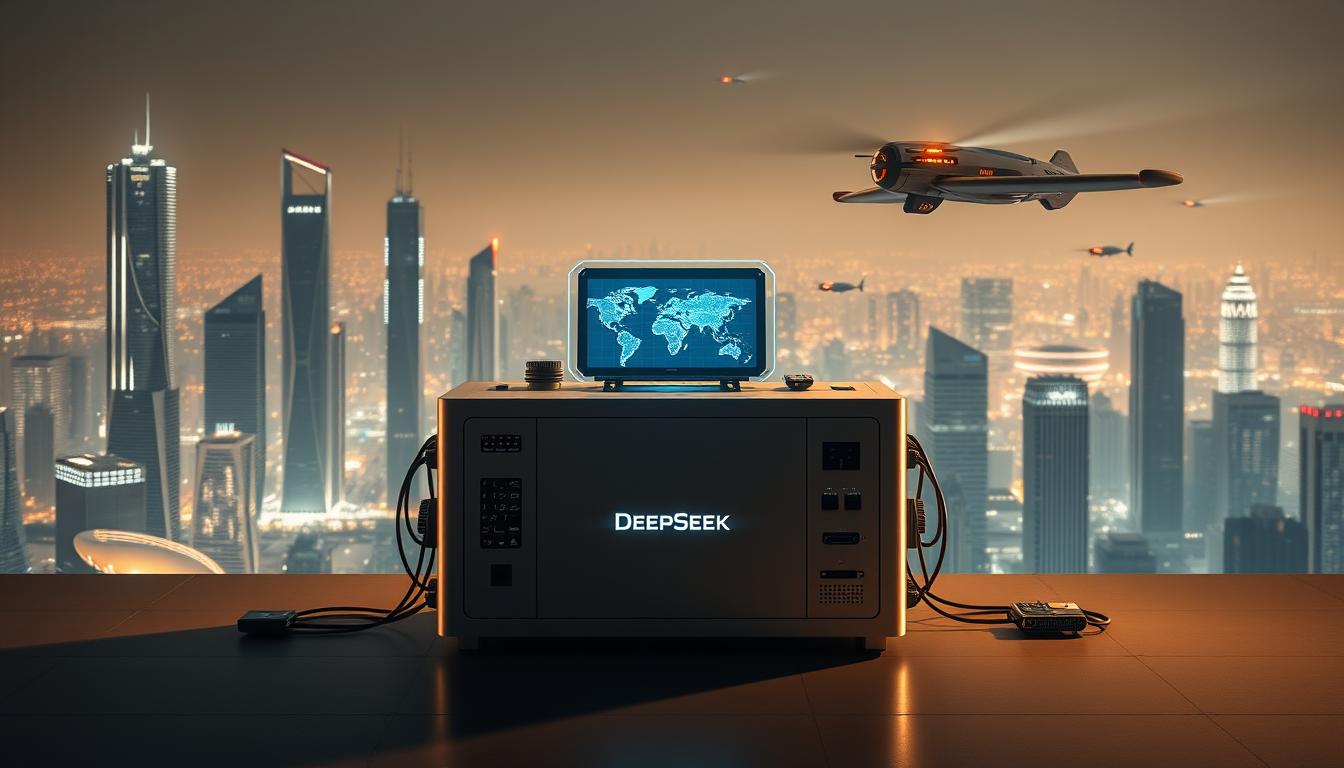Ever wondered what it takes to develop an intelligent system that can think, reason, and act like a human? The answer lies in leveraging cutting-edge platforms like DeepSeek. This powerful tool is revolutionizing the way we approach automation and intelligence in modern projects.
DeepSeek stands out as a groundbreaking platform, offering advanced natural language processing and reasoning capabilities. It’s designed to help developers and business owners create sophisticated agents that can handle complex tasks efficiently. Whether you’re new to AI or an experienced developer, this guide will walk you through every step of the process.
From setting up your development environment to deploying and fine-tuning your final creation, this comprehensive guide ensures you have all the information you need. Let’s dive into the world of intelligent systems and explore how DeepSeek can transform your projects.
Introduction to AI Agents and DeepSeek
Intelligent systems are reshaping industries, and AI agents are at the forefront of this transformation. These agents are software programs designed to perform tasks autonomously, making decisions based on user inputs and environmental data. They’re not just tools; they’re intelligent partners that enhance efficiency and productivity.
What Are AI Agents?
An agent is a system capable of acting independently to achieve specific goals. Key characteristics include:
- Autonomy: Operates without constant human intervention.
- Reactivity: Responds to changes in its environment in real-time.
- Adaptive Learning: Improves performance over time by learning from data.
These features make AI agents invaluable in fields like customer support, automation, and decision-making. For example, they can handle complex queries, process refunds, and execute commands with precision.

An Overview of DeepSeek’s Role
DeepSeek plays a pivotal role in powering these agents. Its advanced natural language processing and reasoning capabilities enable agents to understand and respond to user inputs effectively. Unlike traditional models, DeepSeek offers cost-effective solutions without compromising on performance.
For instance, it supports multilingual interactions, making it ideal for global markets. Its efficient processing ensures quick responses, which is crucial for real-time applications. This platform is not just a tool; it’s a game-changer for developers and businesses alike.
By leveraging DeepSeek, you can create agents that are not only intelligent but also adaptable to diverse needs. This introduction sets the stage for exploring the technical aspects of building and optimizing these systems in the following sections.
Understanding DeepSeek AI Models
When it comes to developing intelligent systems, choosing the right model is critical. DeepSeek offers a range of models designed to meet diverse needs, from natural language processing to real-time coding. These models are not just tools; they are the backbone of intelligent agents that can transform industries.

Comparison with Industry-Leading Models
DeepSeek stands out when compared to other industry leaders like OpenAI’s GPT. One of its key advantages is computational efficiency. For instance, DeepSeek’s models activate only 37 billion parameters during inference, making them resource-efficient without compromising performance.
Another area where DeepSeek excels is cost. Training DeepSeek R1 cost approximately $5.6 million, significantly lower than the billions spent by competitors. This cost-effectiveness makes it an attractive option for businesses looking to leverage advanced AI without breaking the bank.
- Efficiency: DeepSeek models are optimized for real-time applications, ensuring quick responses.
- Cost: Lower training and operational costs compared to competitors.
- Multilingual Support: Ideal for global markets, offering seamless interactions in multiple languages.
Unique Capabilities of DeepSeek
DeepSeek’s models are not just efficient; they are also highly capable. One standout feature is their advanced reasoning abilities. These models can handle complex problem-solving tasks, making them ideal for industries like legal tech and financial advisory services.
Another unique capability is their strength in coding. DeepSeek models can generate and debug code in real-time, a feature that enhances productivity for developers. This functionality is particularly useful for automating software development processes.
“DeepSeek’s models combine efficiency, cost-effectiveness, and advanced capabilities, making them a game-changer in the AI industry.”
In terms of performance, DeepSeek models have proven to be on par with more expensive alternatives. For example, they achieve high accuracy in tasks like logical inference and multilingual comprehension. This makes them a reliable choice for businesses seeking robust AI solutions.
By leveraging DeepSeek’s unique capabilities, you can create intelligent agents that are not only powerful but also adaptable to various industries. Whether it’s automating customer support or optimizing financial decisions, DeepSeek’s models deliver exceptional results.
Setting Up Your Development Environment
Creating a reliable development environment is the first step toward building intelligent systems. A well-prepared setup ensures smooth progress and minimizes errors during the development process. This section will guide you through the essential hardware and software requirements, along with detailed steps to install the DeepSeek SDK and its dependencies.
Hardware and Software Requirements
Before diving into the installation process, ensure your system meets the necessary specifications. Here’s a quick checklist:
- Hardware: A multi-core processor (Intel i7 or equivalent), 16GB RAM, and a GPU with at least 8GB VRAM.
- Software: Ubuntu 20.04 or Windows 10/11, Python 3.8 or higher, and Docker for containerization.
- Tools: Git for version control and a code editor like Visual Studio Code.
These requirements ensure your system can handle the computational demands of developing and testing agents effectively.

Installing DeepSeek SDK and Dependencies
Once your system is ready, follow these steps to set up the DeepSeek SDK:
- Clone the SDK repository using Git:
git clone https://github.com/deepseek/sdk.git. - Navigate to the SDK directory:
cd sdk. - Install dependencies:
pip install -r requirements.txt. - Configure environment variables for API access:
export DEEPSEEK_API_KEY=your_api_key.
These steps ensure the SDK is properly installed and ready for use. Pay close attention to each step to avoid common pitfalls.
Configuring System Settings
Proper configuration is crucial for seamless integration. Here’s how to set up your system:
| Setting | Description |
|---|---|
| Environment Variables | Ensure variables like DEEPSEEK_API_KEY are correctly set for API access. |
| System Path | Add the SDK directory to your system’s PATH for easy access. |
| Permissions | Grant necessary permissions to avoid access issues during runtime. |
Following these configurations ensures your development environment is optimized for building and testing agents.
A solid development environment sets the stage for successful project execution. By carefully preparing your system and following the steps outlined above, you’ll be well-equipped to create intelligent systems that deliver exceptional results.
How to Build AI Agent Using DeepSeek: The Ultimate Guide
Getting started with DeepSeek involves a straightforward process that unlocks powerful tools for creating intelligent systems. This section will guide you through the essential steps to register, configure API access, and integrate the platform for seamless development.
Registering on the DeepSeek Platform
The first step is setting up an account. Visit the official DeepSeek website and click on the “Sign Up” button. Fill in your details, including your email and password. Once registered, you’ll gain access to the platform’s dashboard, where you can manage your projects and settings.

After completing the registration, verify your email to activate your account. This ensures secure access to all features. The process is quick and user-friendly, making it easy for both beginners and experienced developers to get started.
API Access and Configuration
Next, you’ll need to obtain your API key. Navigate to the “API Keys” section in your dashboard. Click on “Generate New Key” and copy the provided key. This key is essential for integrating DeepSeek’s services into your development environment.
To configure the API, add the key to your project’s environment variables. For example, use export DEEPSEEK_API_KEY=your_api_key in your terminal. This ensures secure and seamless communication between your application and the platform.
DeepSeek’s API is designed for scalability, allowing you to handle complex tasks efficiently. Whether you’re building a chatbot or automating workflows, this setup lays the foundation for robust agent creation.
By following these steps, you’ll be ready to harness the full potential of DeepSeek. Each small step contributes to building a fully functional and intelligent system tailored to your needs.
Implementing Natural Language Processing for AI Agents
Natural language processing (NLP) is the backbone of intelligent systems, enabling them to understand and interact with users effectively. By leveraging DeepSeek‘s advanced algorithms, developers can create agents that process, interpret, and respond to user inputs with precision. This section explores the techniques and strategies for implementing NLP to enhance agent performance.

Processing and Understanding User Inputs
Accurate input handling is critical for effective NLP. DeepSeek excels in processing raw user data, cleaning it, and transforming it into actionable insights. This involves tokenization, where text is broken into meaningful units, and syntactic analysis to understand sentence structure.
For example, when a user asks, “What’s the weather in New York?”, the agent identifies key entities like “weather” and “New York” to provide a relevant response. This level of understanding ensures the system delivers accurate and contextually appropriate answers.
Context Awareness and Entity Recognition
Maintaining context is essential for multi-turn conversations. DeepSeek’s NLP capabilities allow agents to remember previous interactions, ensuring continuity. For instance, if a user follows up with “What about tomorrow?”, the agent recalls the earlier query about weather and adjusts its response accordingly.
Entity recognition further enhances this process by identifying and extracting key information from input data. This includes names, dates, and locations, which are crucial for tasks like scheduling or navigation.
| Technique | Description |
|---|---|
| Tokenization | Breaks text into meaningful units for analysis. |
| Syntactic Analysis | Understands sentence structure and grammar. |
| Entity Recognition | Extracts key information like names and dates. |
| Context Management | Maintains conversation history for continuity. |
By integrating these NLP techniques, DeepSeek empowers agents to handle complex interactions efficiently. Whether it’s customer support or decision-making, these capabilities ensure the system delivers exceptional results.
Developing Decision-Making and Action Modules
Effective decision-making is the cornerstone of any intelligent system, enabling it to perform tasks autonomously and efficiently. In this section, I’ll explore how DeepSeek empowers agents to make logical decisions and execute secure actions, ensuring optimal functionality.
Chain-of-Thought Reasoning Strategies
Chain-of-thought reasoning is a powerful technique that allows agents to break down complex problems into manageable steps. This approach mirrors human thinking, enabling the system to analyze, reason, and arrive at logical conclusions. For example, when faced with a multi-step task, the agent evaluates each component sequentially, ensuring accuracy and coherence.
DeepSeek’s implementation of this strategy involves a cyclic loop: Thought, Action, Pause, Observation, and Answer. This process ensures the agent remains context-aware and adaptive, delivering precise results even in dynamic environments.

Executing Secure and Controlled Actions
Once a decision is made, the next critical step is execution. DeepSeek ensures every action is secure and controlled, minimizing risks and maintaining system integrity. Techniques like input validation and error handling are employed to prevent vulnerabilities.
For instance, when an agent processes a financial transaction, it verifies the input data, checks for anomalies, and logs the action for auditing. This layered approach guarantees safety and reliability.
| Technique | Description |
|---|---|
| Input Validation | Ensures data integrity before processing. |
| Error Handling | Manages exceptions to prevent system failures. |
| Action Logging | Records executed actions for auditing and analysis. |
By integrating these modules, DeepSeek enhances the overall functionality of agents, making them reliable tools for industries like finance, healthcare, and customer support. Whether it’s automating workflows or providing personalized recommendations, these capabilities ensure exceptional performance.
Enhancing AI Memory and Context Management
Memory management is a critical component in creating intelligent systems that deliver seamless user experiences. Effective memory design ensures agents can maintain context and provide personalized interactions. This section explores techniques for optimizing both short-term and long-term memory in AI systems.

Short-Term Memory Techniques
Short-term memory is essential for maintaining session continuity. It allows agents to retain context during a single interaction. For example, in a customer support chat, the system remembers the user’s previous queries to provide coherent responses.
One effective method is tokenization, where the agent breaks down the conversation into manageable units. This ensures the system can process and respond to each part accurately. Another technique is context stacking, where the agent layers previous inputs to maintain a logical flow.
Long-Term Memory Optimization
Long-term memory enables agents to store and retrieve information over extended periods. This is crucial for personalized experiences. For instance, an agent can remember a user’s preferences to tailor future interactions.
DeepSeek’s advanced models support long-term memory through data indexing and retrieval mechanisms. These allow the system to access stored information quickly and efficiently. Regular updates ensure the memory remains relevant and accurate.
| Technique | Description |
|---|---|
| Tokenization | Breaks conversations into manageable units for processing. |
| Context Stacking | Layers previous inputs to maintain logical flow. |
| Data Indexing | Organizes information for quick retrieval. |
| Regular Updates | Ensures memory remains relevant and accurate. |
By implementing these memory techniques, DeepSeek enhances the overall robustness of AI systems. Whether it’s maintaining session continuity or delivering personalized experiences, these strategies ensure exceptional performance.
Integrating Advanced Features and Optimizations
Optimizing an intelligent system requires a blend of advanced techniques and regular updates to ensure peak performance. By focusing on both tuning and security, you can create a stable and efficient agent that meets user expectations. This section dives into practical strategies for enhancing functionality and maintaining system integrity.

Advanced Techniques for Performance Tuning
Improving performance starts with identifying bottlenecks in your system. I recommend profiling your agent to pinpoint areas that need optimization. For instance, reducing latency can significantly enhance user satisfaction. Techniques like caching frequently accessed data and optimizing database queries are effective.
Another approach is to leverage DeepSeek’s efficient processing capabilities. By activating only necessary parameters, you can minimize resource usage without compromising functionality. This ensures your agent operates smoothly, even under heavy workloads.
Procedures for Implementing Security Updates
Regular security updates are essential to protect your agent from vulnerabilities. Start by monitoring your system for potential threats. Implementing automated patch management can streamline this process, ensuring timely updates.
Additionally, secure your API access by rotating keys periodically. This reduces the risk of unauthorized access. DeepSeek’s platform supports robust security features, making it easier to maintain a secure environment.
| Technique | Description |
|---|---|
| Profiling | Identifies bottlenecks for targeted optimization. |
| Caching | Reduces latency by storing frequently accessed data. |
| Patch Management | Automates security updates for timely protection. |
| API Key Rotation | Enhances security by periodically changing access keys. |
By integrating these techniques, you can ensure your agent remains efficient and secure. A proactive approach to maintenance and optimization is key to delivering exceptional results.
Best Practices for API Security and Error Handling
Ensuring robust security and effective error handling is essential for maintaining the integrity of your API-driven systems. By implementing actionable best practices, you can safeguard sensitive data and minimize disruptions in your agent operations.
Securing API Keys and Access Controls
Protecting your API keys is the first line of defense. I recommend storing keys in environment variables or secure vaults to prevent exposure. Avoid embedding them in client-side code, as this increases vulnerability.
Implementing access control mechanisms is equally important. Use role-based permissions to restrict access to authorized users only. For example, limit administrative privileges to specific team members to reduce risks.
- Encrypt API keys: Use encryption to add an extra layer of protection.
- Enforce rate limits: Prevent abuse by limiting the number of requests per user.
- Rotate keys periodically: Regularly update API keys to minimize unauthorized access.
Implementing Robust Error Handling
Effective error handling ensures your agent can manage unexpected issues gracefully. Start by validating all user inputs to prevent injection attacks. This step is crucial for maintaining system integrity.
Use clear error codes to identify and resolve issues quickly. For instance, a 401 Unauthorized error indicates an invalid API key, while a 403 Forbidden error signals exceeded request limits. Logging these errors helps in diagnosing and fixing problems efficiently.
| Error Code | Description |
|---|---|
| 401 Unauthorized | Invalid or missing API key. |
| 403 Forbidden | Request limit exceeded. |
| 500 Server Error | Internal API issue. |
By integrating these strategies, you can enhance the reliability and security of your API-driven systems. Proactive measures ensure your agent delivers consistent performance, even in challenging scenarios.
Deploying and Fine-Tuning Your AI Agent
Deploying an intelligent system into production is a critical step that ensures seamless integration and optimal performance. This phase involves not only launching the agent but also fine-tuning it to meet user expectations and adapt to real-world scenarios. Let’s explore the key strategies for successful deployment and continuous improvement.
Optimizing Response Quality and Speed
Once your agent is deployed, the focus shifts to optimizing its performance. Start by analyzing response quality. Ensure the agent provides accurate and contextually relevant answers. Techniques like multi-threading can enhance speed by handling multiple requests efficiently.
Reducing latency is another priority. Implement caching mechanisms to store frequently accessed data. This minimizes the time required to retrieve information, improving user satisfaction. Additionally, fine-tune the API settings to balance resource usage and responsiveness.
Monitoring and Continuous Improvement
Continuous monitoring is essential to maintain high performance. Use tools like Arize and LangSmith to track key metrics such as response time, accuracy, and user engagement. Regularly review these metrics to identify areas for improvement.
Gathering user feedback is equally important. Encourage users to share their experiences and suggestions. This input helps you understand real-world usage patterns and make informed decisions for updates.
| Metric | Description |
|---|---|
| Response Time | Measures the speed of the agent’s replies. |
| Accuracy | Evaluates the correctness of responses. |
| User Engagement | Tracks how users interact with the agent. |
By implementing these strategies, you can ensure your agent remains efficient and effective. Regular updates and adjustments are key to maintaining peak performance over time.
“Continuous improvement is not just a goal; it’s a necessity for any intelligent system to thrive in dynamic environments.”
Deploying and fine-tuning your agent is an ongoing process. By focusing on optimization and monitoring, you can create a system that delivers exceptional results and adapts to evolving user needs.
Exploring Real-World Applications of DeepSeek AI Agents
Across industries, intelligent systems powered by DeepSeek are transforming workflows and delivering measurable results. These agents are not just theoretical concepts; they are actively solving real-world problems, enhancing efficiency, and driving innovation. Let’s dive into some concrete applications that highlight their impact.
Industry Use-Cases and Automation Examples
In the healthcare sector, DeepSeek agents are streamlining patient data management. They analyze medical records, identify trends, and even assist in diagnosing conditions. This reduces the burden on healthcare professionals and improves patient outcomes.
The finance industry is another area where these agents shine. They analyze market trends, predict stock movements, and automate trading strategies. This not only saves time but also minimizes human error, ensuring more accurate financial decisions.
Customer service has also been revolutionized. DeepSeek-powered chatbots handle inquiries, process refunds, and provide personalized recommendations. This enhances the customer experience while reducing operational costs for businesses.
| Industry | Application | Benefit |
|---|---|---|
| Healthcare | Patient data analysis | Improved diagnostics |
| Finance | Market trend analysis | Accurate predictions |
| Customer Service | Chatbot interactions | Enhanced experience |
These examples demonstrate the versatility of DeepSeek agents. By automating repetitive tasks and providing actionable insights, they empower businesses to focus on strategic goals. The result is increased productivity and a competitive edge in the market.
As more industries adopt these solutions, the potential for innovation grows. From logistics to education, the applications are endless. The key is to identify areas where automation can make the most significant impact and implement solutions tailored to specific needs.
“DeepSeek’s ability to adapt to diverse industries makes it a game-changer in the world of intelligent systems.”
By leveraging DeepSeek, businesses can unlock new opportunities and stay ahead in an increasingly competitive landscape. The future of automation is here, and it’s powered by intelligent agents that deliver real value.
Future Trends and Innovations in AI Agent Development
The future of intelligent systems is evolving rapidly, driven by advancements in technology and innovation. As we look ahead, DeepSeek continues to play a pivotal role in shaping the next generation of agents. These systems are becoming more sophisticated, with enhanced capabilities and improved security measures.
Emerging Capabilities and Model Enhancements
One of the most exciting trends is the evolution of models that redefine intelligent automation. Future agents will feature advanced decision-making algorithms, enabling them to handle complex tasks with minimal oversight. For example, DeepSeek is integrating real-time processing features that allow agents to respond instantly to dynamic environments.
Another key enhancement is the ability to process multimodal inputs. This means agents can analyze text, images, and audio simultaneously, broadening their functionality. Such advancements are expected to revolutionize industries like healthcare, finance, and customer service.
The Evolving Landscape of AI Security
As agents become more integrated into critical systems, security remains a top priority. Future trends focus on innovative access and control measures. For instance, DeepSeek is developing robust encryption techniques to protect sensitive data and prevent unauthorized access.
Proactive threat detection is also gaining traction. By leveraging machine learning, agents can identify and neutralize potential risks before they escalate. This ensures a safer and more reliable user experience.
| Trend | Impact |
|---|---|
| Multimodal Processing | Enhances functionality by analyzing diverse inputs. |
| Real-Time Decision-Making | Improves responsiveness in dynamic environments. |
| Advanced Security Measures | Protects data and ensures system integrity. |
These advancements highlight the transformative potential of DeepSeek in shaping the future of intelligent systems. By staying ahead of these trends, businesses can unlock new opportunities and maintain a competitive edge.
“The integration of advanced capabilities and robust security measures ensures that DeepSeek remains at the forefront of AI innovation.”
As we move forward, ongoing research and development will continue to drive progress. The future of agents is not just about automation; it’s about creating systems that adapt, learn, and evolve over time.
Closing Thoughts on Mastering AI Agent Development with DeepSeek
Mastering the development of intelligent systems requires a blend of strategy, innovation, and continuous learning. Throughout this guide, I’ve shared key steps to help you create effective agents that deliver real value. Adhering to best practices and gathering feedback ensures your solutions remain relevant and impactful.
Using DeepSeek as your platform provides a reliable foundation for innovative business solutions. Its advanced capabilities empower you to tackle complex challenges with confidence. By optimizing your development process, you can maintain high-quality agents that evolve with user needs.
Looking ahead, embracing a proactive approach is essential. Continuously refine your skills and leverage the latest advancements to stay ahead in this rapidly changing field. With the right mindset and tools, you can unlock the full potential of intelligent systems and drive meaningful results.


